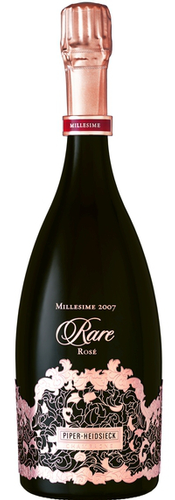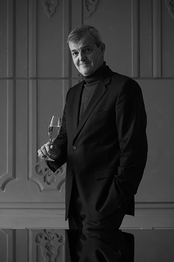The venerable Champagne house, Piper-Heidsieck, founded in 1785, has just released a new Prestige Cuvée, Rare Rosé 2007, which now joins its sister prestige cuvée, Piper-Heidsieck Rare. This follows the tradition of many major Champagne houses that offer both a white and rosé Prestige  Cuvée. The boom in rosé wine sales has dictated this change for Piper-Heidsieck . Rosé wines, including Champagnes, are now enjoying greater popularity than ever before.
Cuvée. The boom in rosé wine sales has dictated this change for Piper-Heidsieck . Rosé wines, including Champagnes, are now enjoying greater popularity than ever before.
Champagne Piper-Heidsieck is presently the 6th largest Champagne house, producing around six million bottles a year. Most of that production is its non-vintage Brut, a very popular Champagne, with its bright red label. Only a very small amount of Rare is produced, but much of it goes to the U.S., the world’s largest market for Prestige Cuvée Champagnes.
Champagne Piper-Heidsieck previewed its first Prestige Cuvée, Rare, with the 1976 vintage. I first became aware of the Rare with its third vintage, the 1985 Rare, which I thought was excellent. It was followed by the 1988 Rare, which was even better. Unfortunately, very few bottles of these older vintages are still for sale today. Piper’s eighth Rare vintage, the 2002, is currently available, and it is sensational, of the same quality as the fabled 1988, and presented in a beautiful bottle. Made from 70 percent Chardonnay and 30 percent Pinot Noir, all primarily sourced from Grand Cru vineyards, it is intensely concentrated. Even though it is now 14 years old, the 2002 Rare is not nearly at its peak of maturity. I would recommend holding it for at least six more years before drinking it.
As for the cost of the Rare 2002, its suggested retail price is $225, but I have seen it listed as low as $140 to $157 in many fine wine shops in the U.S., with an average price range of $170 to $175. At these prices, the 2002 Rare is a great value, and would make a superb gift to Champagne lovers.
The Chef de Cave of Champagne Piper-Heidsieck, the esteemed Régis Camus, has done an amazing job improving the quality of Piper-Heidsieck. Camus has been with Heidsiecks’ Champagnes since 1994, when both Champagne Charles Heidsieck and Piper-Heidsieck were owned by the spirits company, Rémy-Cointréau, producers of Rémy-Martin Cognac.
The previous winemaker, the legendary Daniel Thibault, had already established Charles Heidsieck as one of the best Champagne houses in existence. But he passed away before he had a chance to turn around the fortunes of the much larger Piper-Heidsieck. Camus became the chef de cave of both houses, but soon realized that Piper-Heidsieck needed the most work, and since 2003 has focused only on Piper-Heidsieck. Camus has been named “Sparkling Winemaker of the Year” eight times by Europe’s International Wine Challenge organization, a tribute to the progress he has made with Champagne Piper-Heidsieck.
Personally, I have seen a huge improvement in the quality of Piper-Heidsieck’s NV Brut in the last 20 years. It is now one of the better NV Bruts produced (average retail price, $35 to $40; it is also available in half-bottles and magnums).
In 2011, EPI, the French luxury goods company, purchased both Champagnes Charles Heidsieck and Piper-Heidsieck from Rémy-Cointréau. Christopher Descours, Chairman of EPI and a Champagne lover, was eager to create a new Rosé Prestige Cuvée for  Piper-Heidsieck. Régis Camus had been working on the idea since the early 2000s. But the vintage and the color of the Rare Rosé had to be just right.
Piper-Heidsieck. Régis Camus had been working on the idea since the early 2000s. But the vintage and the color of the Rare Rosé had to be just right.
And now we have Piper-Heidsieck’s ninth Rare since 1976–2007 Rare Rosé, the new baby. It debuted in Paris two weeks ago; I was fortunate to be the first U.S. wine writer to taste it two days ago, with Régis Camus in New York. In one word, it is…magnificent! The color is as gorgeous as I have seen in a Rosé Champagne: It is a deep salmon pink, just a bit tinged with orange and peach. It is luminous; the Rare Rosé truly stands out in the glass as soon as it is poured. We used perfectly shaped white wine glasses, which enhanced its aromas and flavors (avoid using flutes with this Champagne–or any quality Champagne, for that matter).
The most surprising quality of Piper’s Rare Rosé 2007 is its depth and concentration. Although 2007 is regarded as a good vintage in the Champagne region, it also has the reputation of being rather precocious, with its Champagnes being generally ready to drink soon. Not so the Rare Rosé, for sure. I asked Camus why he chose the 2007 vintage for the Rare Rosé debut. Camus replied that the grapes he chose–56 percent Chardonnay, 44 percent Pinot Noir, mainly from Grand Cru vineyards–were perfect for the Champagne he wanted to produce. The Rare Rosé is elegant, with great finesse. It is subtle, with subdued aromas at this point, but with a purity of concentrated fruit and amazing depth. I would think that it needs ten years to fully develop, and yet it will be enjoyable to drink within five years. I rate the Piper-Heidsieck Rare Rosé 2007 a 98.
Only 1500 bottles were produced, 750 of which will sell in the United States. A Champagne of this quality is usually purchased by the top restaurants, but it will also be available in the better wine shops this autumn. Piper Heidsieck’s suggested retail price is $450, but hopefully it will be discounted, just as the 2002 Rare. Yes, it is expensive, but since only 750 bottles are available, I am sure it will have no problem selling. It is of the same quality as the other great Rosé Champagnes, such as Louis Roederer Cristal Rosé ($500 to $600); Dom Pérignon Rosé ($300 to $350); or Krug Rosé ($300 to $320).
Régis Camus thought that the Rare Rosé might be available in magnums at some time in the future. He has not yet decided if he will produce a 2007 Rare white at this point. Camus mentioned that both a Rare white and Rosé could sometimes be produced in the same year, depending on the quality of the vintage.
As for me, I am looking forward to my next opportunity to taste Piper-Heidsieck’s Rare Rosé 2007.
